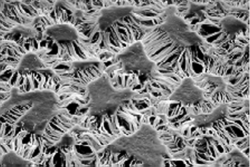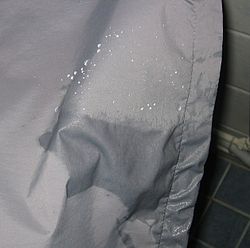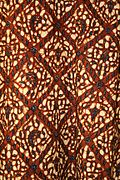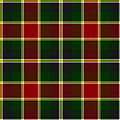- Gore-Tex
-
Gore-Tex is a waterproof/breathable fabric, and a registered trademark of W. L. Gore and Associates. It was co-invented by Wilbert L. Gore, Rowena Taylor, and Gore's son, Robert W. Gore. Robert Gore was granted U.S. Patent 3,953,566 on April 27, 1976, for a porous form of polytetrafluoroethylene (the chemical constituent of Teflon) with a micro-structure characterized by nodes interconnected by fibrils. Robert Gore, Rowena Taylor, and Samuel Allen were granted U.S. Patent 4,194,041 on March 18, 1980 for a "waterproof laminate." For its invention, Robert W. Gore was inducted into the National Inventors Hall of Fame in 2006.[1]
Contents
History and manufacture
In 1966, John W. Cropper of New Zealand developed and constructed a machine for producing stretched PTFE tape. Rather than file for a patent, however, Cropper chose to keep the process of creating expanded PTFE as a closely held trade secret and required his producer and its employees to sign confidentiality agreements.[2]
In 1969, Bob Gore independently discovered expanded polytetrafluoroethylene (ePTFE) and introduced it to the public under the trademark Gore-Tex,[3] for which he promptly applied for and obtained U.S. Patent 3,953,566, issued April 27, 1976 and U.S. Patent 4,187,390, issued February 5, 1980.
In the 1970s Garlock, Inc. infringed Gore's patents and was promptly sued by Gore in the Federal District Court of Ohio. After a "bitterly contested case" that "involved over two years of discovery, five weeks of trial, the testimony of 35 witnesses (19 live, 16 by deposition), and over 300 exhibits," (quoting the Federal Circuit) the District Court held Gore's patents to be invalid. On appeal, however, the Federal Circuit disagreed in the famous case of Gore v. Garlock, reversing the lower court's decision on the ground, inter alia, that Cropper forfeited any superior claim to the invention by virtue of having concealed the process for making ePTFE from the public, thereby establishing Gore as the legal inventor.[4]
PTFE is made using an emulsion polymerization process that utilizes the fluorosurfactant PFOA,[5][6] a persistent environmental contaminant. As Gore-Tex is PTFE-based, PFOA is used in its production.[7]
Design
Gore-Tex materials are typically based on thermo-mechanically expanded polytetrafluoroethylene (PTFE) and other fluoropolymer products. They are used in a wide variety of applications such as high performance fabrics, medical implants, filter media, insulation for wires and cables, gaskets, and sealants. However, Gore-Tex fabric is best known for its use in protective, yet breathable, rainwear.
The simplest sort of rain wear is a two layer sandwich. The outer layer is typically nylon or polyester and provides strength. The inner one is polyurethane (abbreviated: PU), and provides water resistance, at the cost of breathability.
Early Gore-Tex fabric replaced the inner layer of PU with a thin, porous fluoropolymer membrane (Teflon) coating that is bonded to a fabric. This membrane had about 9 billion pores per square inch (around 58 billion pores per square centimeter). Each pore is approximately 1/20,000 the size of a water droplet, making it impenetrable to liquid water while still allowing the more autonomous water vapour molecules to pass through.
However it was found that when used in clothing the exposed Teflon membrane layer was easily damaged, as well as being compromised by exposure to the wearer's own perspiration. As a result a third, monolithic PU layer was added, denoted in the schematic (see right) as the inner of the "protection" layers. Finally either a loose fabric shell layer, or a bonded coating (typically a grid fabric, or occasionally a carbon layer as in Gore-Tex Paclite Shell) is added to the garment to protect the membrane sandwich. This final design has been criticized as offering greatly reduced performance and more marketing benefits than performance ones.[8]
More recent fabrics such as eVent, Nikwax Analogy and Epic avoid the need for this inner PU coating[9] and have been shown to have higher breathability as a result, while still being rainproof.[10]
Care of Gore-Tex fabric
- As dirt - and even human sweat - will block the pores that allow Gore-Tex to breathe, clothing that uses it should be kept clean for best performance, as well as hygiene and appearance reasons.
- Both wear and cleaning will reduce the performance of Gore-Tex clothes by wearing away the Durable Water Repellent (DWR) treatment on the surface of the fabric. The DWR prevents the face fabric from becoming wet and thus reducing breathability. However, the DWR is not responsible for the jacket being waterproof. This is a common misconception, so when the face fabric becomes soaked due to an absence of DWR, there is no breathability and the wearer's sweat will cause condensation to form inside the jacket. This may give the appearance that a jacket is leaking when is not, but the DWR is still crucial to the best performance of any membrane-based waterproof. It can be reinvigorated by tumble drying the garment or ironing on a low setting. If this does not work, re-proofing the garment by applying a topical water repellency restorative (DWR treatment) for outdoor fabrics can be used. Wash-in re-proofers are not recommended for this use, as they can hinder the garment's breathability.[11]
- A guide to maintaining Gore-Tex fabrics is available.[11]
Other uses
Gore requires that all garments made from their material have taping over the seams, to eliminate leaks. Gore's sister product, Windstopper, is similar to Gore-Tex in being windproof and breathable, but has ability to stretch and is not waterproof.
Gore-Tex is used as a medical prosthesis for replacing torn anterior cruciate ligament and posterior cruciate ligament.[12] and is also playing an increasing role in the conservation of illuminated manuscripts.[13]
Explosive sensors have been printed on Gore-Tex clothing leading to the sensitive voltammetric detection of nitroaromatic compounds.[14]
The Gore naming system does not imply specific technology or material but instead specific set of performance characteristics.[15]
Patent expiration
Now that the main Gore-Tex patent has expired, there are several other products on the market with similar characteristics that use similar technology.[16]
See also
References
- ^ "Hall of Fame inventor Profile: Robert Gore". Invent.org. 2006. http://www.invent.org/hall_of_fame/240.html. Retrieved 2011-01-20.
- ^ "W. L. Gore Associates v. Garlock, Inc., 721 F.2d 1540, 220 USPQ 303 (Fed.Cir.1983), cert. denied', 469 U.S. 851, 105 S.Ct. 172, 83 L.Ed.2d 107 (1984).". http://www.openjurist.org/721/f2d/1540/wl-gore-associates-inc-v-garlock-inc.
- ^ Norman E. Clough. "Innovations in ePTFE Fiber Technology". http://www.gore.com/MungoBlobs/168/901/ePTFE_INNOVATIONS_PAPER.pdf.
- ^ "Gore, supra.". http://www.openjurist.org/721/f2d/1540/wl-gore-associates-inc-v-garlock-inc.
- ^ Lehmler, HJ (March 2005). "Synthesis of environmentally relevant fluorinated surfactants—a review". Chemosphere 58 (11): 1471–96. doi:10.1016/j.chemosphere.2004.11.078. PMC 2587313. PMID 15694468. http://www.pubmedcentral.nih.gov/articlerender.fcgi?tool=pmcentrez&artid=2587313.
- ^ Lau C, Anitole K, Hodes C, Lai D, Pfahles-Hutchens A, Seed J (October 2007). "Perfluoroalkyl acids: a review of monitoring and toxicological findings". Toxicol Sci. 99 (2): 366–94. doi:10.1093/toxsci/kfm128. PMID 17519394. http://toxsci.oxfordjournals.org/cgi/reprint/99/2/366.pdf.
- ^ Renner, Rebecca (June 2003). "Concerns over common perfluorinated surfactant". Environ Sci Technol. 37 (11): 201A–2A. doi:10.1021/es032467q. PMID 12831000. http://pubs.acs.org/doi/abs/10.1021/es032467q.
- ^ Stevenson, Seth (2003-07-11). "Shopping for waterproof raincoats". Slate.msn.com. http://slate.msn.com/id/2085417/. Retrieved 2011-01-20.
- ^ "Search by Trademark". FabricLink. http://www.fabriclink.com/search/trademark-search.cfm#E. Retrieved 2011-01-20.
- ^ "Knowledge Base". ProLite Gear. 2004-02-10. http://www.prolitegear.com/site/xdpy/kb/00029/index.html. Retrieved 2010-10-09.
- ^ a b "Care Centre". Gore-Tex. http://www.gore-tex.com.au/www/348/1001127/displayarticle/care-centre--1001207.html. Retrieved 2011-01-20.
- ^ Woolker et al. "The Gore-Tex prosthetic ligament as a salvage procedure in deficient knees. SpringerLink http://www.springerlink.com/content/tnpgmqa06q14c6yh/
- ^ Singer, Hannah. “The Conservation of Parchment Objects Using Gore-Tex Laminate.” The Paper Conservator 16, 1992: 40-45.
- ^ Chuang, MC et al. "Textile-based Electrochemical Sensing: Effect of Fabric Substrate and Detection of Nitroaromatic Explosives." Electroanalysis 22, 2010: 2511-2518.[1]
- ^ "Fall 2008 Fabrics and Technologies". 2007-10-18. http://www.goaao.com/Marmot-files2/F08%20Fabrics%20and%20Technologies.doc.
- ^ Logue, Victoria. (2005). Hiking and Backpacking. Menasha Ridge Press. p 74. ISBN 0-89732-584-2. Google books. Retrieved on December 31, 2008.
External links
Categories:- Technical fabrics
- Brand name materials
- 1976 introductions
- American inventions
Wikimedia Foundation. 2010.






